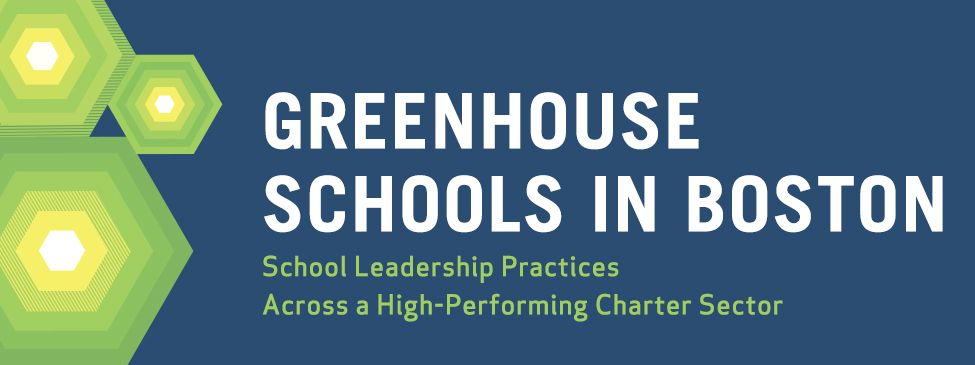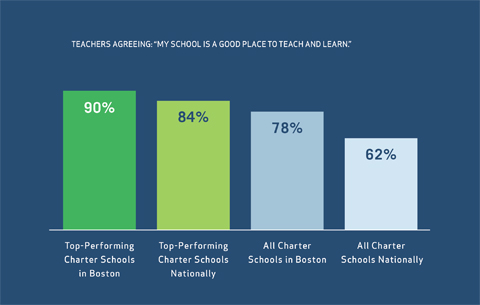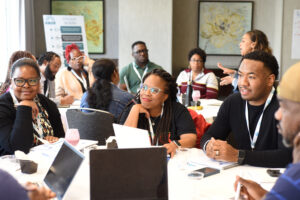Here in Boston, we’ve been making headlines for our successes in a few areas lately: football, for one, and breaking snowfall records, for another. But more importantly, Boston’s schools are still making the news for their strong performance, compared to their peers in other major cities.
In particular, Boston’s charter sector has received widespread attention for its outstanding student outcomes, with charter students outpacing both their local district peers and charter school peers nationally in learning gains. What’s happening in Boston’s charter sector to account for these outcomes? And what can school leaders in other cities and charter sectors learn from these successes?
We wondered if there might be particular practices that school leaders across the Boston charter sector are using that could be contributing to school cultures where students and teachers thrive. This isn’t a random hypothesis. Back in 2010, we started exploring the relationship between school culture and student outcomes. To do this, we surveyed teachers on their school environments using a diagnostic tool called Instructional Culture Insight, and we compared those results against other data, like student outcomes and teacher attrition rates. The bottom line? School environments where teachers thrive—and that get great outcomes for kids—aren’t random.
The Insight survey asks teachers things like how clearly their school leader defines expectations for quality instruction, how often they observe effective colleagues in action, and whether or not they feel supported to maintain consistent expectations for students. We found that affirmative responses to three questions in particular were closely aligned with higher overall teacher satisfaction and stronger student outcomes. Those statements were:
“The expectations for effective teaching are clearly defined at my school.”
“Teachers at my school share a common vision of what effective teaching looks like.”
“My school is committed to improving my instructional practice.”
Two years ago, we published a report called Greenhouse Schools: How Schools Can Build Cultures Where Teachers and Students Thrive. Since then, we’ve used Insight to continue to collect a wealth of data on school leadership practices and school culture across the country. This national data set gave us the opportunity to explore the leadership practices in Boston and investigate what the sector might be doing differently than other schools to get these results.
Today, we’re partnering with NewSchools Venture Fund to release Greenhouse Schools in Boston: School Leadership Practices Across a High-Performing Charter Sector. The paper digs into the data from Insight results in the two-thirds of Boston’s charter sector that voluntarily participated in our research. We also visited several schools to meet with teachers and school leaders and capture some of the nuance that a survey can’t capture.
The paper is available for download today. Here are the big headlines:
Boston’s charter schools on average do have stronger instructional cultures than other charter sectors we’ve surveyed. A majority of participating Boston charter schools (18 out of 23) fall in the top half of instructional culture scores for all surveyed charter schools nationwide. Practically, this means in terms of instructional culture, the average Boston charter school looks more like a top-performing charter school in our national data set.
While not every charter school in Boston is acing Insight, there are more schools at the top end of the spectrum (and fewer at the bottom end) than we see in other sectors. Boston’s range of Insight Index scores, from highest to lowest, is narrower than what we’ve seen in other major charter sectors, suggesting that strong leadership practices are more consistent across the sector than elsewhere.
The practices we identified in Greenhouse Schools are on display across the participating Boston charter schools. In particular, school leaders in Boston charters prioritize creating consistent learning environments that are focused on student growth, teacher development through observations and peer modeling, early hiring with a high bar, and right responses to good (and bad) performance. The details look different from school to school, but we saw strong common themes emerge, from deliberately organizing time and space to facilitate teacher collaboration, using data thoughtfully to inform instruction, and maximizing opportunities to make great teaching visible and celebrated.
We hope the detail in the paper’s narrative and case studies will be useful alongside the quantitative data as school leaders try to cultivate their own environments where teachers and students can thrive. We’ll continue to explore the relationship between school culture and student outcomes on this blog throughout the coming year.









